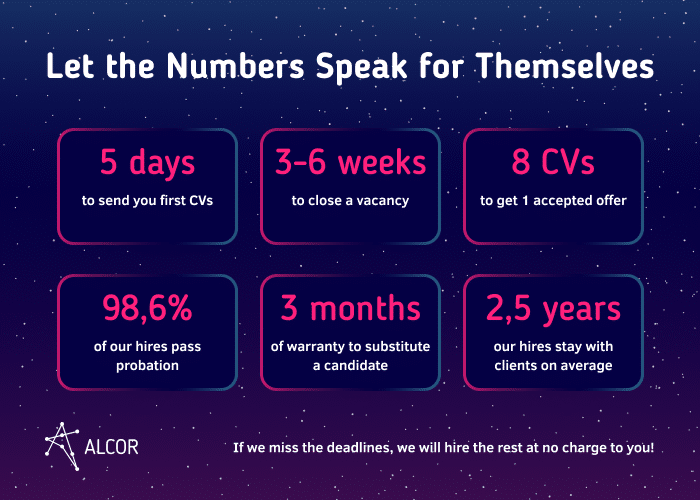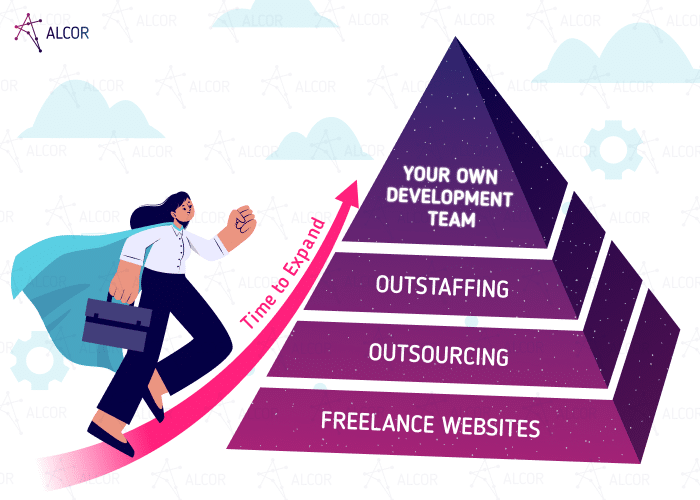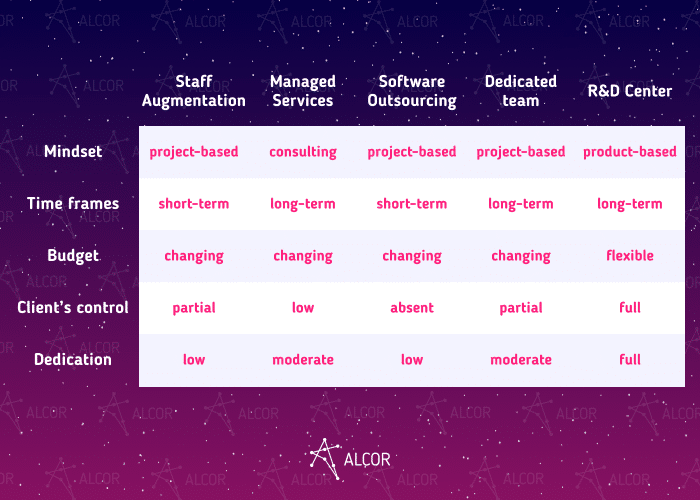About 62% of IT decision-makers identify hiring qualified programmers as their biggest obstacle to scaling up their business, with 42% citing challenges related to employee retention. One of the possible solutions to this issue is engaging IT staff augmentation.
I’m Dmytro Ovcharenko, CEO at Alcor. We help international IT companies expand to LATAM and Eastern Europe by assembling software development teams under the R&D center solution.

Having managed operational processes for tech companies for over 15 years, I’ve realized that team expansion poses one of the greatest challenges. As such, I’ve decided to delve into the topic of staff augmentation to provide insights for those considering it.
In this article, I’ll dwell on the pros and cons of this model, different types of staffing providers, and the rates of augmented staff. Additionally, I’ll offer insights into various team augmentation practices to assist you in selecting the most suitable approach. So, let’s dive in!
What is IT Staff Augmentation?
Staff augmentation is a cooperation model that allows companies to enlarge their in-house team of software developers with external tech experts temporarily. This approach is adopted by IT businesses to bridge skill gaps or enhance capacity for particular projects.
IT Staff Augmentation Industry Overview
IT executives turn to offshore IT staff augmentation when they recognize that their onsite team is no longer capable of meeting all the needs of their enterprise. Some common reasons for this include company growth, seasonal spikes in workload, and the launch of larger or new projects. In such instances, in-house developers may need help to meet deadlines and require external assistance on short notice.
Another reason for using staff augmentation services is the time-consuming recruitment process, primarily influenced by the prevailing talent shortage. The most severe skill gaps are observed in the IT sector, particularly in AI, data analytics, AR/VR engineering, cloud computing, and cybersecurity. The United States alone faces a 78% skill gap in the IT industry. The US labor market saw a whopping 88,000 tech positions unfilled in the last quarter of 2023.
Gartner predicts that the issue of talent shortage will continue to prevail. As a result, the global staff augmentation services market is forecasted to grow at a CAGR of 3.53% between 2021 and 2025, reaching a total incremental spend of $81.87 billion.
IT Staff Augmentation Trends & Forecasts
Focus on Advanced IT Skills
Staff augmentation for IT projects has emerged as a crucial phase in the expansion of tech companies, enabling them to secure engineers possessing highly sought-after technical skills. In today’s landscape, IT enterprises strive to incorporate cutting-edge technologies like AI, ML, IPA, blockchain, cybersecurity, and cloud computing. As these technologies continue to advance, the demand for professionals skilled in these domains is expected to skyrocket, leading to a significant shift in clients’ staffing requirements in the near future.
Staffing Automation
After coming out of lockdowns, the business world saw a huge acceleration in remote work and automation trends. Clients now expect fast and convenient solutions from technical staff augmentation providers. Therefore, vendors are investing in virtual tools for video conferencing, tracking and messaging systems, skill testing tools, and incorporating ChatGPT practices to sort the best software engineers from the rest.
Global Market Accessibility
Sometimes, regional partners lack the expertise and capabilities to offer the best talents. That’s why IT resource augmentation trends also include engaging distributed workforce around the globe. The pandemic taught us how to manage remote teams, so today, companies are ready to tap into a much larger global talent pool to find suitable and rare programmers.
Continued Growth
The IT staff augmentation industry is unlikely to see any signs of slowing down in the upcoming years, as qualified and on-demand IT experts will be needed more than ever before. A recent survey by Clutch found that 83% of small companies will maintain or increase their spending on outsourced business services. Moreover, with the rising demand for IT professionals, Latin America has been frequently selected by American tech companies for nearshore staff augmentation services. Custom software development, web development, IT managed services, and mobile app development are the most common staff augmentation projects to outsource to LATAM countries.
IT Staff Augmentation Process
IT staff augmentation services provide a flexible solution for quickly expanding the in-house development team and addressing skill gaps. With remote work becoming more prevalent, tech executives can access top talent globally, making it cost-effective for short-term projects.
IT staff extension solutions serve as an effective transition stage for team upgrading. It begins with hiring freelancers to ensure safety, cost savings, and convenience before scaling up to outsourcing for broader project support and enhanced capabilities.
At this point, business executives delegate the whole software development project to outsourcing agencies. When the necessary task is fulfilled, business executives seek consistent results and often transition to outstaffing or technical team augmentation. This model provides access to skilled talent on a project-by-project basis, but companies may find the service fees costly in the long term.
This is when top managers go all-in for their own offshore development team. They meticulously select the ideal location, comparing the top places for remote work. Tech leaders often hire a team in Eastern Europe or Latin America due to their abundant talent pool (2 million software developers), expertise, and cost-effectiveness. Afterward, they assess and choose the top providers in this location, prioritizing those with seamless tech recruitment capabilities. To cement their presence in the offshore market, IT companies may take it further by establishing their own offshore development center with full-cycle operational support.

Benefits And Challenges of IT Staff Augmentation
Before diving into IT team augmentation, it’s crucial to understand the full scope of this model. Let’s explore its benefits and challenges to gain a comprehensive understanding. Starting with the advantages:
Access to expertise & resources
IT staffing augmentation opens doors to vast pools of software developers, each with unique qualifications and rare skills that your company needs to thrive. Here are a couple of staff augmentation examples.
Imagine your company is delving into AI development. Tapping into team augmentation in Mexico, Brazil, or Argentina is a smart move. These nearshoring destinations boast IT professionals scoring over 90 points in data science. If you need software engineers proficient in programming, mobile development, and cloud computing, turning to Romanian and Polish software developers or using IT staff augmentation in Ukraine is the way to go.
Moreover, talent augmentation firms often come equipped with the latest technologies. This saves you a pretty penny, as you wouldn’t have to purchase these technologies yourself.
Quick team scaling
In today’s fast-paced business world, adaptability is critical to staying ahead of the curve. That’s where the staff augmentation model comes in like a knight in shining armor, providing much-needed tech talent on demand. Instead of spending weeks scouring the market for the right talent, augmentation providers have assembled teams ready to hit the ground running. For example, if you suddenly find yourself in need of a couple of middle engineers for a project, you can quickly bridge this gap with augmented staff, avoiding all the hustle and bustle.
Flexibility
Among other benefits of IT staff augmentation is the flexibility it offers to scale your team of developers up or down as needed. Whether you identify talent shortages among your existing workforce or face an urgent need for additional staff to complete a project, team augmentation services can provide the necessary support. Furthermore, once you’ve leveraged the expertise of your augmented employees and achieved your project goals, you can easily adjust your team size by ending their engagement.
Cost savings
When you opt to hire full-time in-house employees, you must allocate significant resources towards their recruitment, onboarding, training, management, and procuring necessary equipment for their workspace. However, with IT augmentation services, you can bypass these concerns, as it becomes your vendor’s responsibility to provide the outsourced personnel with everything they need for productive work.
Even though the staff augmentation business model may seem an excellent solution to address skill gaps in your company quickly, it has some downsides you need to be aware of. Here are the core ones:
Team indifference
When using staff augmentation resources, it’s crucial to remember that these software developers remain official employees of the vendor. They won’t align themselves with your company’s vision, values, and goals, as your project is merely another task to complete. Therefore, you cannot expect the same level of commitment or extra effort from them. In contrast, permanent workers, whether onsite or remote, are often a preferable option for IT companies. Your software product is a valuable asset, requiring a dedicated and hardworking team willing to go the extra mile to achieve outstanding results.
Additional long-term costs
Workforce augmentation is great if engaging it for short-term project outsourcing. If you’re a growing startup needing investment or simply satisfied with the augmented employees’ work and wish to retain them, there’s a catch. Retaining these workers can lead to significant expenses due to buy-out fees for each contractor. Therefore, it’s wise to be strategic from the start and consider hiring full-time workers to avoid paying twice the price in the long run.
Team integration & management
If you opt for IT staff augmentation in Bulgaria or any other offshoring destination, be mindful of potential challenges stemming from differences in work culture, communication styles, and project methodologies. To address these challenges, consider adjusting your management strategies. Begin by devising a streamlined onboarding process for your augmented development team to familiarize them with project details and kickstart work swiftly. Additionally, factor in time zone differences and leverage practical project management tools, communication channels, scheduled team meetings, and precise project objectives to ensure seamless collaboration between teams.
Security & privacy concerns
When cooperating with an augmented team, there’s a high risk of exposing sensitive data. Since these software developers work with you on a temporary basis, there’s a chance they may use your intellectual property in future projects or inadvertently share details of your product with colleagues on other projects, compromising confidentiality. Security measures, non-disclosure agreements, and data protection protocols can mitigate some risks. However, why subject your software to any dangers in the first place? You can avoid potential pitfalls by hiring your own team of loyal developers.
Extended onboarding time
While flexible IT staff augmentation can significantly reduce the time spent sourcing and hiring new IT specialists, it presents another challenge: prolonged onboarding. External employees will require time to familiarize themselves with your product and project details. Additionally, they may need to learn new programs and technologies or upgrade their existing skills. Implementing efficient knowledge-sharing processes and documentation can expedite onboarding and training. However, it’s important to remember that augmented staff will eventually leave after the project is complete. In contrast, the time and resources invested in hiring new in-house software developers will continue to benefit your product development for years to come.
Pros and Cons of Staff Augmentation Services
Let’s sum up the pros and cons of the staff augmentation process for a clearer understanding of the specifics of this cooperation model.
| Pros | Cons |
| Provides access to large pools of software developers with diverse qualifications and rare skills. | An augmented staffing team treats every project as another task, showing limited dedication and effort, thus leading to mediocre quality of the end-product. |
| Allows to cooperate with software developers for a much lower price than in the immediate area. Plus, reduces overhead costs like employee benefits and training. | Integration of external developers into existing teams can be challenging, due to the differences in project methodologies and work cultures, resulting in time-consuming onboarding. |
| Enables quick scaling up or down of resources according to project needs. | Team management gets complicated, as synergy should be maintained between the in-house and external teams. Potentially, it can lead to project delays. |
| Augmented staff bring fresh perspectives and ideas to the project, potentially enhancing innovation and problem-solving. | Differences in communication styles, time zones, or language proficiency between internal and external teams can lead to misunderstandings and delays. |
| Eliminates the need for protracted recruitment processes and onboarding. | Engaging in long-term IT staff augmentation with the intention of retaining external developers may incur buy-out fees, thus leading to increased overall expenses. |
| Helps prevent burnout among existing team members by redistributing workload and providing additional support during peak periods. | Introducing sensitive information to external staff may pose security risks, leading to possible data breaching. |
| When external resources leave after completing their contracts, there’s a risk of knowledge loss if proper documentation and knowledge transfer processes are not in place. |
IT Staff Augmentation Pricing by Country
Imagine you’re considering remote IT staff augmentation but unsure about the best offshoring location to choose. Latin America and Eastern Europe are among the most frequent options for US-based IT companies. So, what are the rates like in these regions? Let’s take a look!
If considering staff augmentation in Latin America, it’s important to note that the average software developer’s compensation here ranges from $25,000 to $56,000 annually. Blockchain developer salary is notably higher, averaging between $32,000 and $56,000 per year. Among the compared locations, Mexico typically offers the lowest rates for software engineers. However, this difference in rates is not substantial.
| Positions | Mexico | Chile | Argentina | Colombia |
| Full-Stack Software Developer | $30,000-$42,000 | $30,000-$43,000 | $35,000-$45,000 | $32,000-$45,000 |
| Front-End Software Developer | $30,000-$40,000 | $33,000-$40,000 | $32,000-$40,000 | $28,000-$45,000 |
| Back-End Software Developer | $32,000-$45,000 | $36,000-$47,000 | $32,000-$44,000 | $30,000-$45,000 |
| Mobile App Developer |
$30,000-$38,000 | $32,000-$40,000 | $30,000-$40,000 | $25,000-$34,000 |
| AI Engineer | $32,000-$45,000 | $38,000-$50,000 | $35,000-$50,000 | $32,000-$45,000 |
| Blockchain Developer | $32,000-$50,000 | $40,000-$56,000 | $35,000-$53,000 | $33,000-$52,000 |
| DevOps Developer |
$30,000-$45,000 | $32,000-$48,000 | $32,000-$45,000 | $32,000-$48,000 |
| QA Engineer | $25,000-$34,000 | $30,000-$38,000 | $28,000-$35,000 | $28,000-$35,000 |
Moving on to staff augmentation in Eastern Europe. The average compensation of software engineers here typically spans between $30,000 and $70,000. IT staff augmentation in Bulgaria stands out as an advantageous choice, offering the most budget-friendly rates for programmers in the region. Similarly, Ukrainian software developers demand comparable rewards, presenting another financially attractive option for foreign IT companies. The highest salaries can be found among Blockchain and DevOps developers, ranging from $34,000 to $70,000 annually.
| Positions | Poland | Bulgaria | Ukraine | Romania |
| Full-Stack Software Developer | $45,000-$60,000 | $35,000-$50,000 | $38,000-$50,000 | $43,000-$60,000 |
| Front-End Software Developer | $37,000-$52,000 | $30,000-$45,000 | $42,000-$48,000 | $37,000-$50,000 |
| Back-End Software Developer | $42,000-$60,000 | $38,000-$50,000 | $40,000-$52,000 | $40,000-$55,000 |
| Mobile App Developer |
$35,000-$50,000 | $30,000-$45,000 | $32,000-$50,000 | $30,000-$43,000 |
| AI Engineer | $40,000-$65,000 | $38,000-$60,000 | $38,000-$65,000 | $40,000-$63,000 |
| Blockchain Developer | $40,000-$70,000 | $34,000-$60,000 | $35,000-$62,000 | $35,000-$68,000 |
| DevOps Developer |
$42,000-$70,000 | $35,000-$60,000 | $40,000-$60,000 | $4-,000-$65,000 |
| QA Engineer | $32,000-$45,000 | $30,000-$40,000 | $30,000-$42,000 | $30,000-$43,000 |
Types of Staff Augmentation Providers
To satisfy the needs of different clients, staff augmentation has transformed into a huge industry with various providers. The most common of them are:
Traditional staffing providers
It is an agency that is also called a “commercial/generalist staffing provider.” Its primary function is to augment your team with the needed expertise in non-critical projects but not the employees with specific skill sets. For example, if you’re the CEO of an IT product company, you may use the services of such staffing vendors to find a good data entry specialist.
Boutique staffing firms
Boutique staffing usually refers to small staffing agencies that can fill even the most challenging roles in your company such as Senior Architect. Such a vendor provides highly customized services and values quality over quantity. That is why you need to pay a fortune for their assistance sometimes.
Staffing platforms
These platforms, which are also called “human clouds,” provide staff augmentation services and connect potential employees and employers. They are divided into gig and on-demand platforms. The only difference between them is that gig platforms do not guarantee that you will receive professional employees. In contrast, on-demand platforms try to provide only curated, interviewed, and vetted talents.
Recruitment agencies
An IT recruitment agency is a staffing provider that hires employees for both critical and non-critical projects of the client. They can perform various staffing services, including e-commerce, AI, IoT, healthcare IT recruiting, and more. Such providers receive a recruitment fee if they find a suitable candidate for a job. As a result, a client gets a fully dedicated development team and retains the autonomy to manage it directly without intermediaries. Partnership with an IT recruitment services company opens doors for many other advantages, such as enhanced employer brand, secured IP rights, and complete control over business expenses.
Among various technical team augmentation providers, Sift, a US-based IT company, opted for tech recruitment to fulfill their staffing needs in Eastern Europe. To achieve their goal of building a dedicated team of engineers, they partnered with Alcor. Leveraging the expertise of our 12 IT recruiters and an account manager, we provided full-cycle IT recruitment along with operational support. Throughout a year-long collaboration, Sift successfully onboarded 30 talented software developers. Encouraged by their Eastern European team’s performance, Sift upgraded it into their own R&D center, further fueling their growth and success.
4 IT Staff Augmentation Tips for Decision Making
How can a business leader choose the most beneficial engagement model in such a variety of options? Here are 4 questions you should ask yourself to make a decision:
-
Do you need project scalability or operational scalability?
Various staff augmentation models offer different scaling alternatives. For instance, an IT outsourcing or staff augmentation solution is a good choice when you need extra resources for specific projects. Contrary to that, managed services and an R&D center with back-office support offer operational scalability and long-lasting assistance as your business grows.
-
Are you looking for a short-term or long-term solution?
Software outsourcing and staff augmentation offer short-term results for tech companies. On the other hand, a dedicated team model is suitable for long-term evolving projects, as well as managed services and an R&D center solution.
-
Which amount of control do you expect to maintain?
Pick an R&D or a dedicated team model to retain full control over the software development process. These models provide the clients with the highest level of independence. Thus, they also offer flexibility and an option to integrate constant changes. In contrast, by getting IT services from software outsourcing providers, tech companies delegate their core business activities and have little impact on the final product.
-
Do you want to have a determined project budget?
Setting up your own development team within an R&D hub offers unparalleled pricing transparency, making it the optimal choice. Other models often come with ambiguities in this regard. For instance, enterprise IT staff augmentation arrangements typically entail buy-out fees over the long term. Meanwhile, outsourcing providers may levy additional charges for adjustments and fixes, making the final price unpredictable. Some intermediaries may require significant upfront investments or consolidate the provider’s fee and the software team’s remuneration into a single invoice. Thus, opting for an R&D center with in-house employees will grant you all the decision-making.
Now, let’s have a look at the available team extension models to help you choose the most suitable for your business.
Staff Augmentation vs. Managed Services
Managed services are also called consulting assistance in specific business tasks. Managed services providers work side-by-side with a client but don’t overtake complete control over the project. They help you manage your tasks more strategically while keeping long-term results in mind.
In contrast to managed services, staff augmentation leaves you completely in charge of all the operations. You are still the manager of your team’s success and have to oversee your new employees’ performance yourself.

Staff Augmentation vs. Software Outsourcing
Software outsourcing is a related term to staff augmentation, but these are different concepts. When outsourcing business processes, you delegate control over a project to third-party vendors. In this way, you get rid of management once and for all.
Compared to the IT outsourcing models, staff augmentation lets you address the hiring challenges if you feel the candidate is unsuitable and monitor the progress of your new team. The reasons for outsourcing IT services, though, are pretty similar to the ones for staff augmentation.
Discover the nitty-gritty of software outsourcing in Romania!
Staff augmentation vs. Dedicated teams
If you are interested in setting up a dedicated team, you’ll receive loyal employees who will supplement your existing team and be focused solely on your project. This way you invest your resources in long-term success and build a relationship with the people who work for you.
Staff augmentation offers you something similar, right? But, the difference lies in management. Dedicated teams typically remain under the supervision of the vendor. Augmented staff, on the other hand, integrates seamlessly into your in-house team operating under your management.
Better Than IT Staff Augmentation: Your Software R&D Center
Some people confuse the terms “dedicated team” and “R&D center,” thinking it’s the same thing. However, setting up a software R&D center presupposes building your own offshore team of programmers via IT recruitment services and operational support.
How does it work? Let’s take the case of People.ai to understand the process. The US-based product company aimed to expand its operations to Eastern Europe. To kickstart this process, they sought a reliable vendor to recruit software developers. After evaluating several options, they chose Alcor for its extensive experience of over 6 years in the market, offering IT recruitment in Poland, Ukraine, Bulgaria, and IT staffing in Romania. With 40 tech headhunters on board, we successfully fulfilled People.ai’s staffing requirements by hiring 25 programmers. Additionally, within just 4 weeks, we launched the client’s own R&D center. We managed all back-office functions, including legal and compliance services, payroll management, office lease negotiations, and IT infrastructure setup, ensuring a seamless transition for People.ai into the Eastern European market.

As you can see, the R&D center solution offers a comprehensive range of services, enabling IT companies to seamlessly enter new markets. By establishing their own team of developers, they can mitigate the risks and challenges associated with traditional IT staff augmentation. Experience the benefits of your own R&D office firsthand by reaching out to us today.
FAQ
1. What is IT staff augmentation?
Staff augmentation implies engaging software developers who are officially employed by another company. This strategy is aimed at filling temporary skill gaps by integrating such external programmers into your in-house team.
2. What are the advantages of a staff augmentation solution?
Benefits of staff augmentation include quick personnel and project scaling, flexibility, cost reduction, and the possibility to fill expertise gaps.
3. Are there any disadvantages of the IT staff augmentation team?
Among the disadvantages of the staff augmentation model are such aspects as lack of dedication from the external development team, additional long-term expenses and onboarding time.
4. Are there any alternatives that are better than IT staff augmentation?
Launching an R&D center with full-cycle IT recruitment services is a winning solution for tech companies with ambitious growth plans. This long-term model offers full control over software development, team management, and business expenses. You will receive committed engineers, secure IP rights and promote your employer brand.
